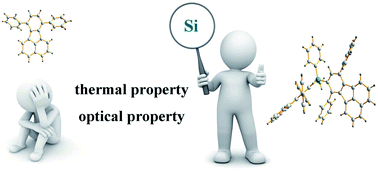The strategy to improve thermal and optical properties of diphenylfluoranthene based on silicon-cored derivatives†
Abstract
A series of novel silicon-cored diphenylfluoranthene derivatives was synthesized in this paper to realize efficient solid-state emission. These silicone-cored diphenylfluoranthene derivatives show better fluorescent properties in the solid state than diphenylfluoranthene because these silicone-cored derivatives exhibit weaker π–π interactions among molecules. What is more, these silicone-cored derivatives exhibit very high thermal stabilities and exceptionally high glass transition temperatures. Interestingly, one silicon-cored diphenylfluoranthene derivative exhibited similar fluorescence emission spectra in both solution and solid state, and may be the most obvious candidate for an efficient solid-state emitter.


 Please wait while we load your content...
Please wait while we load your content...